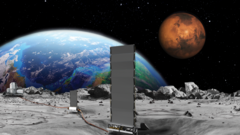NASA has announced its intention to expedite the establishment of a nuclear reactor on the Moon by 2030, as reported by U.S. media sources. This initiative forms part of the U.S. commitment to create a permanent human habitat on the lunar surface, amid escalating efforts from countries like China and Russia, which are also preparing lunar exploration missions.
Politico has highlighted statements from acting NASA chief Sean Duffy, who warned that other nations might unilaterally stake claims on the Moon. The ambitious timeline, however, faces skepticism due to recent budget cuts that have impacted NASA’s resource allocation, leading some scientists to speculate that motivations may be less about science and more influenced by geopolitical competition.
The urgency for such technology is underscored by the need for consistent energy sources for potential lunar economies and ambitious Martian missions. Duffy has urged private companies to propose reactor designs capable of producing a minimum of 100 kilowatts of power—a figure considerably less than what conventional wind turbines generate.
The concept of deploying nuclear reactors on the Moon is not unprecedented. In 2022, NASA allocated $5 million contracts to several companies for reactor designs, and recent announcements from China and Russia suggest plans for a nuclear power station on the Moon by 2035. Many experts agree that nuclear power may be essential to provide reliable energy, as lunar cycles feature weeks of darkness, complicating solar energy reliance.
Researchers emphasize that a viable habitat for lunar crews will necessitate megawatt-level energy generation. Dr. Sungwoo Lim, a senior lecturer at the University of Surrey, points out that beyond just desirability, nuclear energy is becoming a necessity for lunar endeavors.
Despite the technological feasibility, safety concerns arise regarding the launch of radioactive materials into space, requiring extensive oversight and licensure to mitigate risks. The recent directive from Duffy emerges amidst a tumultuous period for NASA, during which substantial budget cuts have sparked concerns over the viability of multiple science projects, including those aimed at Mars exploration.
Many in the scientific community express anxiety that current ambitions for lunar exploration echo a competitive space race focused on territorial claims rather than collaborative exploration. Dr. Simeon Barber, a planetary science expert, notes the risks of narrowing scientific pursuits in favor of national interests, raising questions about the broader mission of exploring the cosmos.
The reference to potential exclusionary zones on the Moon appears linked to the Artemis Accords, an agreement aimed at fostering international cooperation and establishing safety protocols surrounding lunar activities. Duffy's remarks suggest that building a reactor could enable the U.S. to claim specific lunar regions as operational zones, sparking concerns over ownership and access.
Despite NASA’s goal of landing humans on the Moon by 2027 with Artemis 3, logistical hurdles remain prominent. Experts suggest that without a cohesive strategy to transport both personnel and equipment, plans for lunar nuclear power might remain lofty ambitions rather than achievable milestones.

















